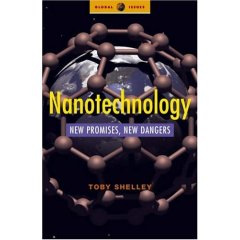Commercial uses of nanotechnology go beyond obvious medical and industrial manufacturing applications to include fashion and consumer products.
Extrapolating from the Top 10 nanotechnology products launched over the past two years - as chosen by the Forbes/Wolfe Nanotech Report published in the USA (please see list below) – food, clothing, cosmetics, consumer electronics and sports equipment manufactures seem the keenest to exploit nanotechnology to enhance their products.
The industries that employ nanotechnologies are admittedly divergent; but this in effect makes apparent the need for a central information source reporting on developments within this discipline. Nanotech Week will give managers and investors a place to turn to for information on sources of new nanotech applications and the investment opportunities they offer.
Top 10 nano products of 2005
(as chosen by Josh Wolfe, Forbes/Wolfe Nanotech Report)
1. ipod Nano featuring NAND and RAM memory chips made by Samsung and Toshiba
2. Canola (rapeseed) oil, a healthier version of which has been created by Israeli start-up NutraLease using 30 nanometer capsules which can seep through tissues for better bio delivery of nutrients.
3. Choco’la Chewing Gum incorporating nanoscale crystals to overcome chocolate’s incompatibility with the polymers that give gum its elasticity.
4. Zelens Fullerence C-60 Face Cream harnesses the power of Fullerene C-60 carbon for cosmetics
5.
6. ARC Outdoors, ArcticSheild Socks a comfortable synthetic fibre sock with permanent resistance to odour and fungus
7. Nano-Tex casual apparel that keeps the wearer dry and warm by pulling moisture away from the body over ten times faster than most resin-treated cotton fabrics available today
8. Behr NanoGuard Paint contains a film which makes it more durable and resistant to water, mildew, stains and grease
9. Pilkington Activ Glass effectively cleans itself, as natural radiation from the sunlight chemically reacts with organic dirt deposits on the surface
10. NanoBreeze Air Purifier from NanoTwin Technologies internally radiates an UV light, charging crystals and creating powerful oxidizing agents that destroy airborne germs and pollutants
(Criteria: Focused on items where nanotechnology is significantly improving a process or product. Source: adapted from Forbes.com)
Further, the number of multinationals involved in nanotech research and applications to date confirms both the global size and breadth of the industry and potential market for this service:
Chevron, Motorola, Uniliver, General Electric, DuPont, Sony, Intel, IBM, Mitsubishi, GAP and L’Oreal.
The Nanotech Industry
The first generation of commercial nanotechnology companies -- those whose business is based on manufactured nanoparticles -- is already with us. Here is a quick overview of the cast of characters that make up this first wave of the nanotechnology industry in the
Corporate Watch, Newsletter 26, October/November 2005
1. Ivory tower tech-heads -- The university spin out company
As state funding for academia decreases and universities seek other ways of bringing in revenue, many are either licensing or selling the results of academic research to private companies, or are setting up their own companies to cash in on academic research discoveries.
Oxonica
Oxonica is the
2. Bomb making boffins -- The military industrial company
It's not just academic research in universities that is having to stand on its own two feet. So too does military research.
QinetiQ Nanomaterials
QinetiQ Nanomaterials is a wholly owned subsidiary of QinetiQ, the partly privatised wing of the Ministry of Defence research agency (see QinetiQ article, page 3). By cashing in on the MoD’s research infrastructure and buying in key manufacturing technology, QinetiQ nanomaterials has established itself as one of Europe’s leading manufacturers of metal nanoparticles. Its products can be used for anything from 'energetic materials' (aka explosives), to ingredients for cosmetics, to fuel catalysts.
QinetiQ’s other venture into nanotechnology is its investment in Australian nanotech company pSivida who are working on medical applications of nano-stuctured ‘Biosilicon’ (a technology initially developed by QinetiQ).
3. Massively tiny and extremely huge -- The chemicals company
Another major player in UK Nano plc is the chemicals industry, which, given its capacity for manufacturing bulk quantities of highly specialised chemicals, has been able to step seamlessly into the new world of making nanomaterials. Examples include
Thomas Swan and Co.
County Durham speciality chemicals company Thomas Swann and Co (in conjunction with Cambridge University), has set itself up as one of the only commercial carbon nanotube manufacturer in the UK.
4. Hardly here at all yet -- The phantom nano company
Looking through a directory of the UK nano industry reveals some companies which, on closer examination, consist of only a website, a single sales representative and a mobile phone number, and turn out to be just the UK sales office of foreign nano companies trying to make it big in the UK and Europe. Examples include JR Nanotech and Guangzhou Heji Trade Co, Ltd.
JR Nanotech
JR Nanotech was set up to market nanomaterials products made in
5. Serving up the nano products -- The nano deliverery company
Right at the other end of the spectrum of the nano industry from the design and manufacture of nanoparticles are the companies which market and sell nanotech based products. These companies will generally have little to do with nanotechnology but are the sharp end of how the public will encounter nanotechnology. In the
Boots
The Boots Soltan sunscreen range contains UV filters based on nanoparticle titanium dioxide. The sunscreens are based on a product called Optisol designed by Oxonica whose active ingredient is manufactured in Belgian company Umicore.
http://www.corporatewatch.org/?lid=2066







No comments:
Post a Comment